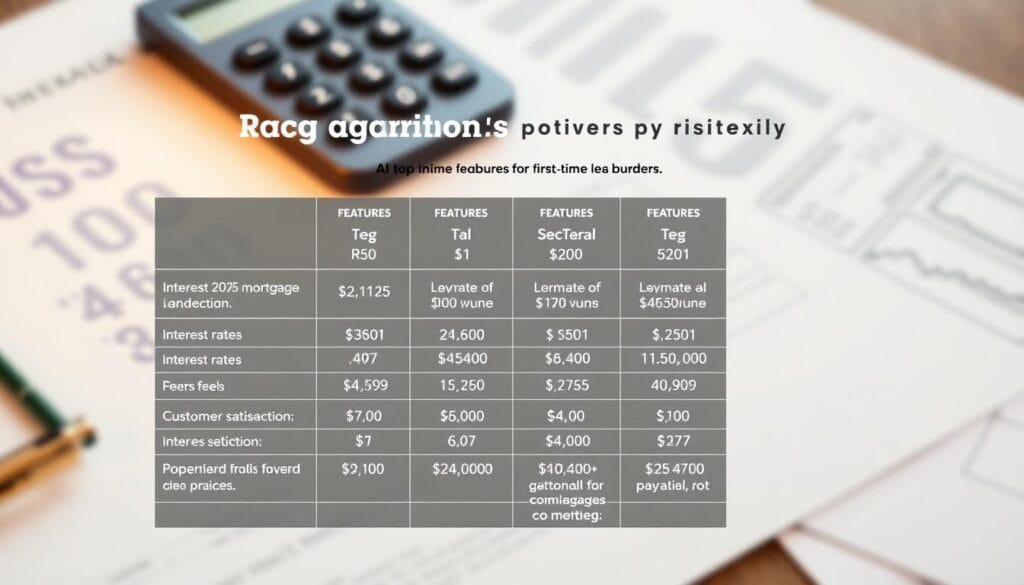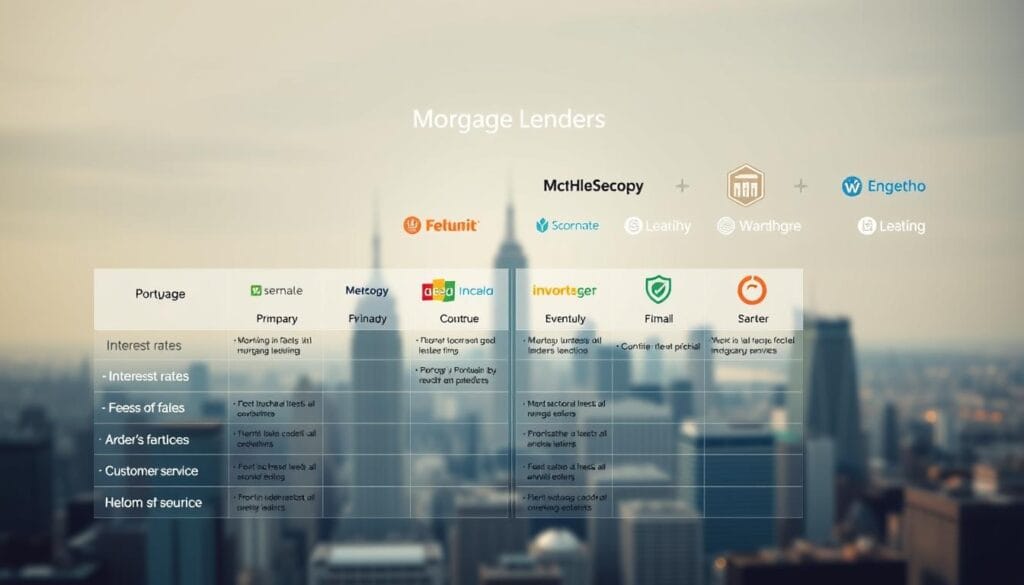Did you know that nearly 40% of home purchases in 2025 are expected to be made by first-time buyers? This statistic highlights the growing importance of understanding the housing market and the options available for those entering it for the first time.
Navigating the competitive housing market can be challenging, especially for newcomers. With rising home prices and evolving loan options, it’s crucial to identify the right resources and programs tailored to first-time buyers. This article provides a detailed analysis of the key challenges and solutions available in 2025.
Using data-driven criteria from CNBC Select’s methodology, we’ve identified eight category-specific lenders that offer unique benefits to borrowers. From proprietary programs like RocketONE+ to VA/USDA loan accessibility, this guide covers essential details to help you make informed decisions.
Key Takeaways
- Nearly 40% of home purchases in 2025 are expected to be made by first-time buyers.
- Rising home prices and evolving loan options make the market competitive.
- Eight category-specific lenders offer unique benefits tailored to first-time buyers.
- Proprietary programs like RocketONE+ provide innovative solutions.
- VA/USDA loans are accessible for military and rural buyers.
Introduction to Mortgage Lenders for First-Time Buyers

Selecting the right lender can significantly impact your home-buying journey. Your choice not only affects your immediate financial obligations but also shapes your long-term financial health.
Why Choosing the Right Lender Matters
The lender you work with can influence your credit score, loan terms, and overall experience. For instance, a credit score of 580 may qualify you for an FHA loan, while a score of 620 or higher opens doors to conventional options.
Down payments also vary. While VA and USDA loans require 0% down, the median down payment for first-time buyers is 9%, according to 2024 NAR data. This flexibility can make a significant difference in your payment structure.
What to Look for in a Mortgage Lender
When evaluating lenders, consider factors like closing costs, prepayment penalties, and rate lock policies. Some lenders, such as Flagstar and Bank of America, offer grants ranging from $7,500 to $15,000 to help offset these expenses.
Additionally, assess the application process. Digital platforms streamline approvals, while hybrid models combine online convenience with personalized support. Veterans United and Rocket Mortgage lead in customer satisfaction, making them strong contenders for your home purchase.
Best Mortgage Lenders for First-Time Buyers in 2025

Navigating the housing market requires a lender that aligns with your unique needs. With various options available, it’s essential to understand the specific benefits each institution offers. This section highlights top choices tailored to different financial situations and goals.
Rocket Mortgage: Best for Low Down Payments
Rocket Mortgage stands out with its RocketONE+ program, allowing buyers to put down as little as 1%. Additionally, the $10K Rocket Homes rebate provides significant savings for new homeowners. Its fully digital process ensures a quick and efficient experience.
Guild Mortgage: Best for Bad Credit
For those with a minimum credit score of 540, Guild Mortgage offers FHA loans with a 17-day closing guarantee. They also consider non-traditional credit factors, such as utility payments, making them a flexible choice.
Better Mortgage: Best for Discounts
Better Mortgage provides a $2K closing cost discount and a 3-minute preapproval process. Their HOPE Grant offers up to $5K in payment assistance, making homeownership more accessible.
PNC Bank: Best for Flexible Loan Terms
PNC Bank offers a $7.5K grant and loan terms ranging from 10 to 30 years. Their Community Loan program requires only 3% down with no PMI, ideal for budget-conscious buyers.
Bank of America: Best for Customer Service
With an A- BBB rating, Bank of America excels in customer service. Their America’s Home Grant provides $7.5K in assistance, and their Edu-Series offers valuable resources for first-time buyers.
Flagstar Bank: Best for Homebuyer Assistance
Flagstar Bank’s $15K first-time grants and 0% Destination Home Mortgage program provide substantial support. Their Power-Up initiative further enhances affordability for new homeowners.
Chase Bank: Best for On-Time Closing
Chase Bank ensures timely closings with a $5K penalty for delays. Their DreaMaker℠ program requires only 3% down, making it a reliable option for buyers seeking efficiency.
Veterans United: Best for Military and Veterans
As the largest VA lender, Veterans United offers 24/7 military support and comprehensive credit counseling. Their programs are tailored to meet the unique needs of service members and veterans.
For more insights on managing finances effectively, explore cashback and rewards apps to maximize your savings.
Understanding Different Types of Mortgages

Understanding the various loan types is essential for making informed financial decisions. Each option comes with unique eligibility criteria, down payment requirements, and benefits. This section explores the key features of conventional, FHA, VA, and USDA loans to help you choose the right fit.
Conventional Loans
Conventional loans are popular for their flexibility. They require a minimum credit score of 620 and a down payment as low as 3% for programs like HomeReady and Home Possible. Unlike government-backed loans, they often require private mortgage insurance (PMI) for down payments below 20%.
These loans are ideal for buyers with strong credit and stable income. They also offer fixed or adjustable interest rates, making them versatile for different financial goals.
FHA Loans
FHA loans are designed for buyers with lower credit scores. A score of 580 or higher qualifies for a 3.5% down payment, while scores between 500 and 579 require 10%. These loans are backed by the Federal Housing Administration, making them accessible to a broader audience.
One unique feature is the FHA 203(k) renovation loan, which combines home purchase and renovation costs into a single mortgage. This hybrid product is perfect for buyers looking to upgrade older properties.
VA Loans
VA loans are exclusive to military service members, veterans, and their families. They require 0% down and have no PMI, but they include a funding fee instead. Loan limits vary, with a base limit of $766K and higher limits in high-cost areas.
These loans also offer streamline refinance options, allowing borrowers to reduce interest rates with minimal paperwork. This makes VA loans a cost-effective choice for eligible buyers.
USDA Loans
USDA loans are tailored for rural and suburban homebuyers. They require 0% down and have income limits set at 115% of the area median. Geographic eligibility is determined by the USDA’s rural development map.
These loans are ideal for buyers in eligible areas who meet income requirements. They also offer competitive interest rates and no PMI, making homeownership more affordable.
When comparing loan types, consider factors like down payments, credit score requirements, and geographic eligibility. Each option has unique advantages, so choose the one that aligns with your financial situation and goals.
Key Features to Compare Among Lenders

When comparing loan providers, it’s essential to focus on key features that align with your financial goals. Understanding these elements can help you make a more informed decision and avoid unnecessary costs or complications.
Interest Rates and Fees
Interest rates vary widely, so comparing them is crucial. A lower rate can save you thousands over the life of your loan. Additionally, pay attention to fees like origination charges, which typically range from 0.5% to 1.5% of the loan value.
Some providers, like Better, eliminate application and underwriting fees entirely. Others, such as Guild, offer credits like $500 for on-time delivery. Always review the APR, which includes points, origination fees, and third-party costs.
Down Payment Requirements
Down payment requirements can range from 0% to 20%, depending on the loan type. For example, Rocket Mortgage’s RocketONE+ program allows as little as 1% down, while VA loans require no down payment.
Assistance programs, such as grants or second liens, can also reduce upfront costs. Compare these structures to find the most affordable option for your budget.
Customer Service and Support
Customer service quality is another critical factor. J.D. Power benchmarks highlight top performers like Veterans United and Rocket Mortgage, which excel in servicing satisfaction.
E-closing adoption rates and multilingual support availability are also worth considering. These features can streamline the process and make it more accessible for diverse borrowers.
Finally, evaluate additional offerings like HELOCs. Flagstar and Bank of America provide contrasting options, so choose the one that best meets your needs.
How to Apply for a Mortgage as a First-Time Buyer

Securing a home loan for the first time can feel overwhelming, but breaking it into manageable steps simplifies the process. Understanding the key stages—pre-approval, documentation, and application—ensures a smoother experience. This section outlines the essential factors to consider when applying for a home loan.
Pre-Approval Process
The pre-approval process is the first step in securing a home loan. It involves a lender reviewing your credit score, income, and debt-to-income (DTI) ratio to determine your eligibility. A pre-approval letter strengthens your position when making an offer on a home.
During this stage, take advantage of the 45-day rate shopping window. Multiple credit inquiries within this period count as a single inquiry, minimizing the impact on your credit score. This allows you to compare offers without penalty.
Documentation Needed
Lenders require specific documents to verify your financial stability. These typically include W-2s, pay stubs, tax returns, and bank statements. Self-employed individuals may need to provide additional documentation, such as profit and loss statements.
For down payments funded by gifts, a gift letter is necessary. This letter confirms the funds are a gift and not a loan. Non-borrowing spouse income may also be considered in certain cases, depending on the lender’s policies.
Tips for a Smooth Application
To ensure a smooth application process, start by improving your credit score and reducing your DTI ratio. Most lenders prefer a DTI below 43%, though exceptions exist for qualified mortgages.
Organize your documents in advance and respond promptly to lender requests. Automated underwriting systems, like DU and LP, streamline approvals by analyzing your financial profile. For more insights on managing finances effectively, explore AI in credit risk assessment to understand how technology enhances accuracy.
Finally, communicate openly with your lender. Ask questions about fees, payments, and timelines to avoid surprises. A transparent relationship with your lender ensures a smoother home-buying journey.
First-Time Homebuyer Assistance Programs

First-time homebuyers often benefit from specialized programs designed to reduce financial barriers. These initiatives, offered at both state and federal levels, provide crucial support to make homeownership more accessible. From payment assistance to grants, these resources can significantly lower upfront costs and ease the burden of entering the housing market.
State and Federal Programs
State-specific programs, like those listed in NerdWallet’s database, offer tailored solutions for local buyers. Federal initiatives, such as the Mortgage Credit Certificate (MCC), provide tax credits covering 20%-50% of interest paid. These options are designed to make homeownership more affordable for first-time buyers.
HUD-approved housing counseling agencies also play a vital role. They offer guidance on navigating these programs and understanding eligibility requirements. This support ensures buyers make informed decisions throughout the process.
Down Payment Assistance
Down payment assistance is a key component of homebuyer assistance. Programs like the National Homebuyers Fund provide up to $5K in grants, while HFA Preferred loans offer 4% assistance through second mortgages. These options help buyers bridge the gap between savings and upfront costs.
Silent second loans and amortizing DPA loans are also available. Silent second loans defer repayment until the home is sold, while amortizing loans require monthly payments. Both options cater to different financial situations.
Grants and Special Loans
Employer-assisted housing programs are another valuable resource. Some employers offer payment assistance or low-interest loans to help employees purchase homes. These initiatives can significantly reduce financial strain.
Special loans, like CHFA’s 3% down payment bridge loans, provide additional flexibility. NHSC rural provider loan repayment links further support buyers in eligible areas. These grants and loans make homeownership achievable for a broader audience.
Factors Affecting Mortgage Approval

Several key factors determine whether your application will be approved. Lenders evaluate your financial profile to assess risk and ensure you can meet repayment obligations. Understanding these elements can help you prepare and improve your chances of success.
Credit Score Requirements
Your credit score is one of the most critical factors in loan approval. For FHA loans, a minimum score of 500 is required, but scores below 580 need a 10% down payment. VA loans have no official minimum, but many lenders set a benchmark of 620. Jumbo loans often require scores of 700 or higher.
Rapid rescore procedures can help improve your credit score quickly by updating credit reports with recent changes. This is particularly useful if you’re close to meeting the requirements but need a slight boost.
Debt-to-Income Ratio
Your debt-to-income (DTI) ratio measures your monthly debt payments relative to your income. Most lenders prefer a DTI below 43%, though some programs allow higher ratios for qualified applicants.
Student loan payment imputation rules can impact your DTI. Lenders often calculate payments based on 1% of the outstanding balance or the actual payment amount, whichever is higher. Understanding these calculations can help you manage your finances more effectively.
Employment and Income Verification
Lenders verify your income and employment history to ensure stability. W-2 employees typically provide pay stubs and tax returns, while self-employed individuals may need profit and loss statements.
Part-time or seasonal income is often calculated differently. Lenders may average earnings over the past two years or use the most recent data. Rental income is also evaluated, with lenders typically capitalizing it at 75% of the gross amount.
For 1099 workers, lenders may require additional documentation compared to W-2 employees. Understanding these requirements can streamline the verification process and improve your chances of approval.
Pros and Cons of Different Mortgage Lenders

Evaluating the strengths and weaknesses of different lenders can help you make a well-informed decision. Each provider has unique features that cater to specific financial needs. Understanding these pros and cons ensures you choose the right fit for your home purchase.
Rocket Mortgage Pros and Cons
Rocket Mortgage is known for its fully digital process and innovative programs like RocketONE+. However, it does not offer HELOCs or construction loans, which may limit options for some buyers.
On the positive side, Rocket Mortgage also offers competitive rates and a streamlined application process. This makes it a strong choice for tech-savvy borrowers seeking efficiency.
Guild Mortgage Pros and Cons
Guild Mortgage stands out for its flexibility, especially for buyers with lower credit scores. It considers non-traditional credit factors, such as utility payments, making it accessible to a broader audience.
However, Guild does not operate in New York, which could be a drawback for residents in that state. Additionally, customer satisfaction reviews are mixed, highlighting the importance of researching local experiences.
Better Mortgage Pros and Cons
Better Mortgage is praised for its discounts and quick preapproval process. It also offers the HOPE Grant, providing up to $5K in payment assistance for eligible buyers.
One limitation is the lack of USDA loan options. Additionally, high HELOC draws may not suit all borrowers. Comparing these features with other loan types can help you decide if Better is the right choice.
For more insights on national vs. local lenders, explore this detailed comparison to understand the trade-offs between digital convenience and personalized service.
How to Choose the Right Lender for You

Choosing the right financial partner is a critical step in securing your future home. This decision impacts not only your immediate financial obligations but also your long-term stability. To make an informed choice, consider your unique financial situation, compare offers, and seek professional advice when needed.
Assessing Your Financial Situation
Start by evaluating your credit scores, as they play a significant role in determining your eligibility for various loan products. A higher score often leads to better interest rates and more favorable terms. Additionally, calculate your debt-to-income ratio to understand how much you can comfortably afford.
Understanding your financial health also involves reviewing your savings for a down payment and closing costs. Tools like the CFPB’s Loan Estimate comparison tool can help you estimate these expenses and compare offers effectively1.
Comparing Lender Offers
When comparing lenders, focus on key factors such as interest rates, fees, and loan terms. The NMLS consumer access portal allows you to verify lender credentials and ensure they meet CRA requirements for LMI lending2.
Additionally, consider the lender’s customer service and support. A transparent and responsive lender can make the process smoother and less stressful. For more insights on finding the best mortgage lender, explore detailed comparisons and reviews.
Seeking Professional Advice
Consulting with a financial advisor or mortgage broker can provide valuable insights tailored to your situation. Brokers often operate under two fee models: borrower-paid and lender-paid. The borrower-paid model ensures the broker’s interests align with yours, while the lender-paid model may introduce conflicts of interest3.
In New York, buyers of co-op apartments may benefit from Cooperative and Condominium Mortgage Loans (CEMAs), which can save on mortgage recording taxes. However, this process requires careful consideration and professional guidance4.
Finally, familiarize yourself with the Loan Estimate (LE) and Closing Disclosure (CD) timelines. These documents, mandated by the TRID rule, ensure transparency and protect consumers throughout the mortgage process5.
Tips for First-Time Homebuyers

Preparing for your first home purchase involves careful planning and strategic decisions. From improving your credit score to understanding closing costs, these tips will help you navigate the process with confidence.
Improving Your Credit Score
Your credit score plays a vital role in securing favorable loan terms. Rapid rescore tactics, such as disputing errors and paying down balances, can boost your score quickly. Aim for a score of at least 620 to qualify for conventional loans, though some programs accept scores as low as 500.
For more insights on managing your finances, explore debt repayment calculators to stay on track.
Saving for a Down Payment
Down payments can range from 0% to 20%, depending on the loan type. Apps like Qapital and Digit help automate savings, making it easier to reach your goal. Consider CD laddering to grow your funds steadily while maintaining liquidity.
Gift funds can also be used for down payments, but ensure you follow sourcing rules to avoid complications.
Understanding Closing Costs
Closing costs typically range from 2% to 5% of the loan amount. These include fees for appraisals, title searches, and attorney services. Escrow accounts can simplify payment management, while non-escrow options offer flexibility.
Transfer taxes vary by state, so research local regulations to avoid surprises. Comparing attorney and title company settlements can also save you money.
Common Mistakes to Avoid When Choosing a Lender
Making the right choice in a lender requires careful consideration and research. Many borrowers rush into decisions without fully understanding the implications, leading to costly errors. This section highlights the most common pitfalls and how to avoid them.
Not Shopping Around
According to the CFPB, 77% of borrowers do not compare multiple lenders. This oversight can cost you an average of $1,500 over the life of your loan. Shopping around allows you to secure competitive rates and terms, avoiding costly mistakes.
Take advantage of the 45-day rate shopping window. Multiple credit inquiries within this period count as a single inquiry, minimizing the impact on your credit score. For more insights on common mistakes to avoid when choosing a, explore detailed comparisons and reviews.
Overlooking Fees and Rates
Hidden fees and high interest rates can significantly increase your overall costs. Always review the Loan Estimate (LE) provided by lenders, which outlines all fees and charges. Look for junk fees, such as unnecessary processing or administrative costs.
Compare the Annual Percentage Rate (APR) across lenders. The APR includes points, origination fees, and third-party costs, giving you a clearer picture of the total expense. Understanding these details can save you thousands over the life of your loan.
Ignoring Customer Reviews
Customer reviews provide valuable information about a lender’s reliability and service quality. Platforms like the Better Business Bureau (BBB) offer complaint resolution rates and customer feedback. Pay attention to recurring issues, such as delayed closings or poor communication.
Additionally, consider the lender’s e-closing adoption rates and multilingual support availability. These features can streamline the process and make it more accessible for diverse borrowers. A transparent and responsive lender can make the process smoother and less stressful.
Future Trends in Mortgage Lending for First-Time Buyers
The landscape of home loans is evolving rapidly, driven by technological advancements and changing consumer expectations. As the housing market adapts to new innovations, first-time buyers can expect more streamlined processes and tailored solutions. This section explores the key trends shaping the future of loan products and services.
Digital Mortgage Applications
AI-driven underwriting is becoming a game-changer in the loan industry. By 2025, 78% of lenders are expected to offer eClosings, significantly reducing processing times. Blockchain technology is also being piloted for title recording, enhancing security and transparency.
Zillow Home Loans is disrupting the market with its tech-forward approach. Their platform integrates AI to provide personalized recommendations, making the application process more efficient. This shift towards digital solutions is transforming how buyers access information and complete transactions.
Increased Focus on Customer Experience
Lenders are prioritizing customer-centric solutions to improve satisfaction. Shared equity investment models, for example, allow buyers to share ownership with investors, reducing upfront costs. This approach aligns with the FHFA’s 2025-2027 Duty to Serve plans, which aim to expand access to underserved communities.
Community Development Financial Institutions (CDFIs) are also gaining traction. These organizations focus on providing affordable programs to low-income buyers, ensuring inclusivity in the housing market. Their expansion is a testament to the industry’s commitment to addressing diverse needs.
New Loan Products and Programs
Innovative products like Variable Rate Mortgages (VRMs) are offering flexibility to buyers. Compared to traditional Adjustable Rate Mortgages (ARMs), VRMs provide more predictable payment structures. Climate risk pricing adjustments are also being introduced, reflecting the growing importance of environmental factors in lending decisions.
These advancements are making homeownership more accessible and sustainable. As the industry continues to evolve, first-time buyers can look forward to a more inclusive and efficient experience.
Conclusion: Finding the Best Mortgage Lender for Your Needs
Securing the right financial partner is crucial for a smooth home-buying experience. When evaluating mortgage lenders, it’s essential to consider key selection criteria across eight categories. Matching the loan type to your financial profile ensures you get the best terms and rates.
HUD counseling sessions offer valuable guidance, helping buyers navigate the complexities of the process. These sessions can clarify eligibility requirements and provide tailored advice.
Looking ahead, the 2025 rate environment, based on Fed dot plots, suggests a stable yet competitive market. This projection can help you plan your home purchase more effectively.
To make an informed decision, use a checklist for final lender comparison. This should include interest rates, fees, and customer service quality. For additional insights, explore the low-fee robo advisors to optimize your financial strategy.
Finally, the CFPB complaint database is a useful resource for verifying lender reliability. Checking this database can help you avoid potential pitfalls and ensure a smooth transaction.
FAQ
What is the minimum credit score needed for a home loan?
How can first-time buyers reduce closing costs?
What are the benefits of FHA loans for first-time buyers?
How does private mortgage insurance (PMI) work?
What documents are needed for a mortgage application?
Can first-time buyers qualify for down payment assistance?
What factors influence mortgage interest rates?
How long does the mortgage approval process take?
What are the advantages of VA loans for military members?
How can buyers improve their chances of mortgage approval?
Source Links
- https://www.nationalmortgagenews.com/news/loan-officer-compensation-rules-are-changing-again
- https://www.consumerfinance.gov/ask-cfpb/what-are-the-different-types-of-mortgage-brokers-and-how-do-they-get-paid-en-1371/
- https://www.nytimes.com/2014/06/15/realestate/nyregion/understanding-the-nyc-co-op-loan.html
- https://www.consumerfinance.gov/ask-cfpb/what-are-the-differences-between-the-loan-estimate-and-the-closing-disclosure-en-1917/
- https://www.consumerfinance.gov/ask-cfpb/what-is-the-truth-in-lending-act-and-the-real-estate-settlement-procedures-act-integrated-disclosure-rule-en-1371/

